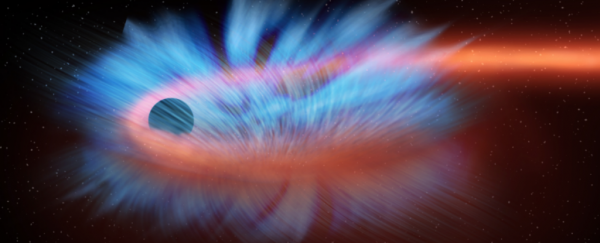Some 290 million light-years away in the centre of a distant galaxy called PGC 043234, a star meandered a little too close to a black hole weighing a few million times the mass of our Sun. The intense gravitational pull of the black hole sucked the star in and tore it to shreds, flinging some of the stellar debris out into space at insanely high speeds, while the rest fell inside, the whole thing causing a powerful X-ray flare that will likely remain for several years.
Lucky for us, scientists at NASA were able to piece together this entire cataclysmic event, and you can see what it looked like in their recreation above. In the immortal words of George Costanza: "That's gotta hurt!"
But what exactly is going on here? The event is known as a tidal disruption, and this the closest we've gotten to one in over 10 years. Using NASA's Chandra X-ray Observatory, Swift Gamma-ray Burst Explorer, and ESA/NASA's XMM-Newton, scientists have gotten the best idea yet of what actually goes on when a star experiences 'death by black hole'.
"We have seen evidence for a handful of tidal disruptions over the years and have developed a lot of ideas of what goes on," said lead researcher Jon Miller from the University of Michigan in the US. "This one is the best chance we have had so far to really understand what happens when a black hole shreds a star."
Miller and his colleagues suspect that after a star is destroyed by a black hole, the stellar debris that isn't hurled back out into space is pulled inwards and heated to millions of degrees, and this generates an incredible amount of X-ray light, which you can see in the video. This X-ray flare will die down eventually as the shredded star parts fall beyond the black hole's event horizon, where even light particles are unable to escape.
Oddly enough, the scientists also picked up the presence of a wind moving away from the black hole during this event, around the time that the X-ray flare dissipates. It appears that as the material gets sucked inside, gaseous star remnants form a hot, smooth disk that moves in an elliptical orbit around the black hole. "Because the centre of the disk is so hot, it expels some of its material outward as wind," Rachel Feltman explains for The Washington Post.
The observations have been published in Nature.
"These results support some of our newest ideas for the structure and evolution of tidal disruption events," said Miller in a press release. "In the future, tidal disruptions can provide us with laboratories to study the effects of extreme gravity."
